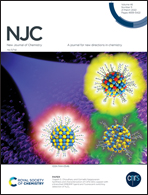Prediction of atomically thin two-dimensional single monolayer SnGe with high carrier mobility: a DFT study
Abstract
Using first principles plane-wave calculations within the framework of density functional theory, we propose a new two-dimensional honeycomb structure of SnGe. The dynamical stability of the SnGe structure is confirmed by the phonon spectra calculations, while ab initio molecular dynamics simulations confirm its thermodynamic stability at 1000 K. The SnGe exhibits a narrow direct band gap of 0.32 eV. Based on effective mass calculations, a relatively high carrier mobility (2.3–7.9 × 104 cm2 V−1 s−1) comparable with graphene is predicted. Mobility is one of the important parameters that characterizes semiconductors, and it determines how charge carriers respond towards an external electric field. In high-performance devices, such as field-effect transistors, a reasonably moderate band gap and high carrier mobility of the channel material are generally required. Owing to its high carrier mobility and direct band gap, SnGe is a viable option for a new generation of nanoelectronic devices. Optical properties of SnGe have also been predicted in this work. The results demonstrate that a small absorption occurs in the infrared region whereas a large absorption takes place in the visible range and above the ultraviolet region of the electromagnetic spectrum.



 Please wait while we load your content...
Please wait while we load your content...